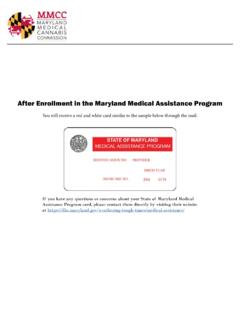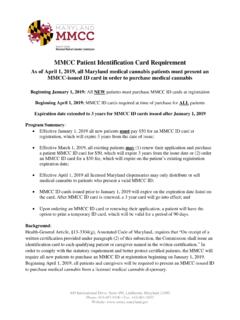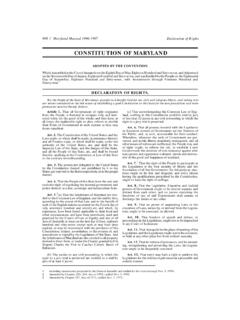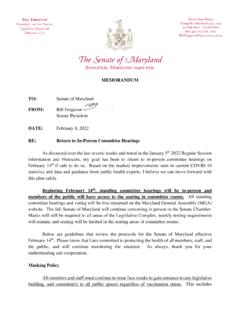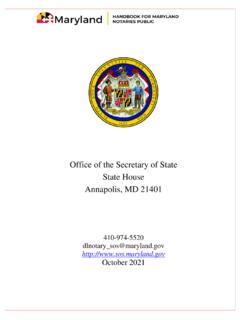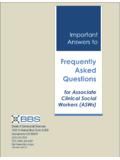Transcription of THE MARYLAND MEDICAL CANNABIS C S TECHNICAL …
1 THE MARYLAND MEDICAL CANNABIS COMMISSION S TECHNICAL AUTHORITY FOR MEDICAL CANNABIS TESTING REVISION December 15, 2020 The MARYLAND MEDICAL CANNABIS Commission (MMCC) has developed this TECHNICAL authority document to define contaminants and corresponding action limits associated with those contaminants in MEDICAL CANNABIS . This information is intended for use by the independent testing laboratories registered with the MMCC. 2 Table of Contents Introduction 3 Sampling 4 Collection Procedure for Laboratory Samples 5 Potency 6 Pesticides 7 Residual Solvents 8 Microbiological Impurities 9 Heavy Metals 11 Excipients 13 Stability Testing 13 Appendix A - MEDICAL CANNABIS Testing Requirements 14 Appendix B - Definitions 15 Appendix C - Stability Testing Protocol- MMCC Licensed Grower 17 Appendix D - Stability Testing Protocol-MMCC Licensed Processor 19 Appendix E - Stability Testing Protocol-Edibles 21 Appendix F - Microbiological Quality Control
2 22 Appendix G- Pathogen Detection Storage Requirements 26 References 27 MMCC s TECHNICAL AUTHORITY FOR MEDICAL CANNABIS TESTING 12/15/20 3 PAGE \* MERGEFINTRODUCTION Analytical testing of MEDICAL CANNABIS for safety and potency is increasingly recognized as a critical and necessary component of the industry for several reasons (Freeman et al. 2016): Laboratory testing minimizes the risk of pesticides, microbes, heavy metals, toxins, and residual solvents from being consumed by an immunocompromised population; Quantification of cannabinoid profiles and potency becomes available for the consumer and aids in determining appropriate dosing for individual use; and Laboratory testing provides a sense of public safety and product quality for the MEDICAL CANNABIS tested.
3 The MARYLAND MEDICAL CANNABIS Commission (MMCC), with the assistance of a scientific work group, has established this TECHNICAL authority to serve as a reference guide for the independent testing laboratories (ITL) to follow when analyzing MEDICAL CANNABIS . This TECHNICAL authority has the force and effect of law and must be followed by ITLs pursuant to the Code of MARYLAND Regulations (COMAR) and The contaminants in MEDICAL CANNABIS identified in COMAR and may not exceed the levels specified in this guidance. MEDICAL CANNABIS safety and potency is to be analyzed based on the most current version of the CANNABIS inflorescence monograph published by the American Herbal Pharmacopeia (AHP), or a scientifically valid methodology that is equal or superior to that of the AHP monograph. COMAR and list the quality control testing requirements for MEDICAL CANNABIS . This TECHNICAL authority provides the lists of contaminants and the acceptable tolerances that the ITL is required to report as stated in COMAR and The tolerances were established following a review of available literature in the CANNABIS industry as well as references from the International Conference for Harmonisation (ICH) Guideline Q3C on Impurities and the ICH Guideline Q3D on Elemental Impurities Guidance for Industry.
4 The four categories of contaminants identified in COMAR and include: Pesticides; Residual Solvents; Microbiological Impurities; and Heavy Metals. In an effective testing program, standardized sampling procedures are an integral component to quality laboratory testing. The data generated from all analytical methods must be consistently reliable and legally defensible. To achieve this, method precision and accuracy measurements should be performed during the sample testing process. This guidance will provide best practices for sample collection by the ITL. All sampling and analysis described in this guidance shall be conducted by an ITL registered with the MMCC and in good standing and accredited to ISO/IEC 17025 by an International Laboratory Accreditation Cooperation (ILAC) recognized third party. The MMCC is committed to evidence-based decision-making when implementing TECHNICAL guidance for the registered ITL.
5 As research into CANNABIS use and safety advances, this TECHNICAL authority will be revised and updated to reflect the state of science as it pertains to the MEDICAL CANNABIS industry. MMCC s TECHNICAL AUTHORITY FOR MEDICAL CANNABIS TESTING 12/15/20 4 PAGE \* MERGEFSAMPLING The objective of a sampling procedure is to ensure the proper collection, clear labeling, proper preservation, careful transportation, and storage of samples by trained personnel for laboratory analyses. Collection of the sample is critical as it must be truly representative of the material being analyzed or the results will not be meaningful. ITLs are required to develop a statistically valid sampling method and collect a representative sample from each batch or lot of final product that is adequate to perform the required testing (COMAR and ). The amount of sample required for cannabinoid or contaminant testing may vary due to sample matrix, analytical method, and laboratory-specific procedures.
6 MEDICAL CANNABIS sampling procedures play an important role in identifying and/or confirming the integrity of a sample, as well as the completeness of request and chain of custody forms. To reliably provide the laboratory with a representative sample, standard sampling methods with descriptive steps must be applied with quality and consistency. All sampling must be consistently performed using accepted methodologies. It is the responsibility of the ITL to define a standard operating procedure that minimizes both imprecision and bias and lists chronological steps that ensure a consistent and repeatable method. When sampling for compliance, all ITLs are required to follow the sampling protocol listed on page 5 of this document, Collection Procedure for Laboratory Compliance and Retention Samples. In addition, the following sampling guidelines shall be demonstrated by the laboratory when performing sampling at a licensed grower or licensed processor: The use of appropriate sampling equipment to avoid contamination; The documentation of observations and procedures used during sample collection; The use of an aseptic collection technique is required for antimicrobial testing; The importance of personal hygiene and use of person protective equipment; and The method used by personnel to consistently obtain samples throughout the batch.
7 (See Appendix A MEDICAL CANNABIS Testing Requirements for information regarding required testing for each sample matrix). MMCC s TECHNICAL AUTHORITY FOR MEDICAL CANNABIS TESTING 12/15/20 5 PAGE \* MERGEFCOLLECTION PROCEDURE FOR LABORATORY COMPLIANCE AND RETENTION SAMPLES Equipment: 1. PPE-Disposable Gloves/Facemask/Shield; 2. Calibrated Scale; 3. Appropriate Sample Collection Vessel; and 4. Isopropyl Alcohol. Procedure: 1) Put on disposable gloves to mitigate the risk for contamination of the sample during the collection process. 2) Ensure the work surface and scale are clean and decontaminated. 3) Label a collection vessel with the appropriate METRC identifier and confirm the batch or lot mass. Do not sample if pertinent information is not available. 4) Retrieve the container you will be collecting the sample from and wipe off the lid of the container if applicable. 5) For usable CANNABIS : The minimum sample volume to be collected from each batch is of the batch mass.
8 The minimum number of sample increments listed below must be collected for the gross sample (this includes both compliance and retain sample). Withdraw samples from the upper, middle, and lower sections of each container, with the upper section sample being taken from a depth of not less than 10 centimeters. In circumstances where there are 1-10 containers in a batch, collect a sample from all containers. Record the time the sample was collected, any inconsistencies with the sampling plan, and any other remarks that may be relevant to data analysis or quality assurance. Max Batch Mass Minimum Sample Size 10lbs 10 sample increments totaling batch mass For processed products (excluding edible CANNABIS products): Each sample must be taken in final product form from randomly chosen positions in the lot. The sample volume collected must meet or exceed minimum volume requirements for all compliance testing performed. 6) Place the sample in the appropriate collection vessel, seal and place to the side.
9 7) Wipe down the scale and work surface using isopropyl alcohol. 8) Dispose of gloves. 9) Document the appropriate chain of custody information ( sample volume) to be recorded in METRC. *The following sample collection procedure is based Pharmacopeia Convention Chemical Tests / 561 Articles of Botanical Origin. 2014 July MMCC s TECHNICAL AUTHORITY FOR MEDICAL CANNABIS TESTING 12/15/20 6 PAGE \* MERGEFPOTENCY Every batch and/or lot of CANNABIS cultivated and/or processed for transfer to a licensed dispensary must pass the required compliance testing listed in COMAR and Potency is analyzed by quantitating the following compounds: 9-Tetrahydrocannabinol (THC); Tetrahydrocannabinolic Acid (THCA); Cannabidiol (CBD); Cannabidiolic Acid (CBDA); The terpenes described in the most current version of the CANNABIS inflorescence monograph published by the American Herbal Pharmacopeia (AHP); Cannabigerol (CBG); and Cannabinol (CBN) To minimize the variability that exists with potency testing of CANNABIS flower, all testing must meet the standard method performance requirements (SMPRs) listed below.
10 For matrices not listed, the method performance requirements must be as close to the published SMPRs as possible. For consistency, the MMCC recommends that ITLs use the sample preparation and the sample analysis methods listed below. The methods have been taken from New York State Department of Health - Wadsworth Center Laboratory of Organic and Analytical Chemistry and AOAC International. *Note: Test samples for potency will consist of a random selection of buds/flower from the analytical sample of CANNABIS flower collected from a licensee. The laboratory is to maintain procedures for homogenization which are supported through method validation. Elevated potency levels will routinely be monitored and confirmed by the MMCC. Enforcement action will be taken for laboratories falsely reporting elevated potency levels in METRC and on Certificates of Analysis. Standard Method Performance Requirements (SMPRs): Dried Plant Material: AOAC SMPR Concentrates: AOAC SMPR Sample Preparation: MEDICAL CANNABIS Sample Preparation Protocols: NYS DOH MML-301 Sample Analysis: Measurement of Phytocannabinoids in MEDICAL Marijuana using HPLC-PDA: NYS DOH MML-300 Quantitation of Cannabinoids in CANNABIS Dried Plant Materials, Concentrates, and Oils AOAC MMCC s TECHNICAL AUTHORITY FOR MEDICAL CANNABIS TESTING 12/15/20 7 PAGE \* MERGEFPESTICIDES COMAR states pesticide applicators and applications shall follow State and federal pesticide requirements for any pesticide applied.
